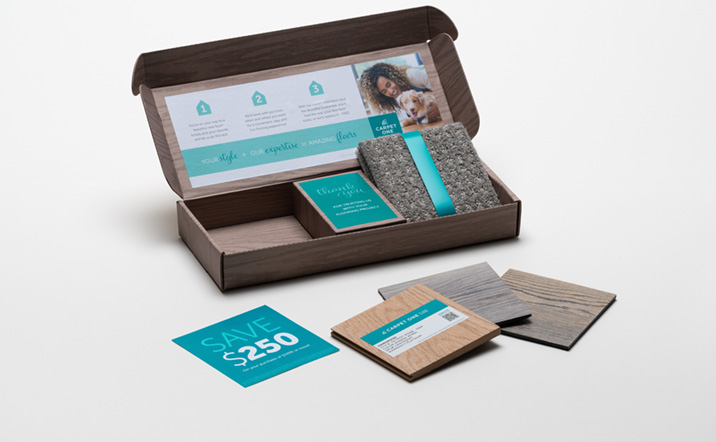
Engineered Hardwood Flooring
Engineered wood flooring has bridged the gap between the aesthetic appeal of solid wood and the durability of synthetic options.

Engineered wood flooring has bridged the gap between the aesthetic appeal of solid wood and the durability of synthetic options.

Our designers share tips and top trends for every season. Discover your next home project with the help of our blog.

Get up to six samples delivered to your door.

Since its debut in the 1960s, engineered hardwood has bridged the gap between the aesthetic appeal of solid wood floors and the durability of synthetic, manmade flooring options.
Engineered hardwood is made up of multiple layers that result in a durable and often water-resistant floor. The top layer, also known as the veneer or wear layer, features natural hardwood. It sits on subsequent layers of manufactured material, usually plywood and HDF.
Thanks to these artificial core and backing layers, engineered hardwood floors are more resilient, less likely to warp or buckle, and easier to install. They also provide some moisture resistance, so you can install them in your kitchen without worrying about cooking messy meals.
Engineered wood flooring looks come in a variety of plank widths, grains, and finishes. The appearance of this flooring is also largely determined by the type of wood you choose. The most common species used for engineered hardwood are ash, hickory, oak, white oak, and red maple.
Wide plank flooring, usually 7 to 8 inches, can make a smaller space feel bigger, plus there are fewer joints when installing. The standard plank width runs from 3 to 6 inches and provides the look of a classic wood floor. Looking for a more unique design? You might like mixed length, which includes a combination of standard and wide plank.
The wood grain of engineered wood floors varies. Do you prefer distinctive knots, swirls, and spirals, or would you rather see subtle waves and lines? Whatever your choice, the detailed texture of wood grain adds a natural element to this engineered flooring option.
Once you've determined the species of wood you'd like, consider the finish that will best suit your design aesthetic. Light wood or gray wood floors can help a space feel brighter and roomier while medium finishes create a warm, cozy atmosphere. Engineered wood flooring with a dark finish adds contrast, especially in larger rooms and open floor plans.
Hardwood engineered for floors is a resilient, durable choice for your home —more so than solid wood. Thanks to the partially manmade layers, engineered wood can withstand changes in humidity and moisture better. This should ease your mind when you’re looking for an ideal flooring solution in your kitchen or bathroom, since engineered hardwood can better withstand spills and messes underfoot.
To ensure your engineered hardwood flooring looks its best for years to come, think about the type of traffic you expect in your home when choosing the thickness of the wear layer. High traffic, pets, and heavy furniture may scratch flooring over time, and thicker wear layers often allow for sanding and refinishing, depending on the manufacturer's instructions. You can also look for engineered wood flooring options with a scratch-resistant top coat, to be doubly protected from your new puppy’s claws.
Under the best conditions, engineered wood floors can last 20 years or more. How long they last in your home will depend on a few factors, including:
To get the most from your new flooring, look into what warranties are available. Carpet One Floor & Home offers warranty protection to make sure your new engineered hardwood floor stands the test of time.
You've got a few installation options depending on the type of engineered hardwood:
When it comes to engineered hardwood flooring, we recommend relying on a professional installer. An experienced pro can ensure a quality installation that gives you the best look, durability, and life available. Plus, you can enjoy peace of mind with the comprehensive warranty a professional installer can provide.
There’s good reason that so many homeowners choose engineered hardwood floors for their new homes. Engineered flooring is:
It suits most rooms, including bathrooms, kitchens, and laundry rooms. Engineered wood also works well in below-grade locations like finished basements and completed attics.
Yes! Engineered hardwood has the ability to hold up in below-grade locations. Some engineered wood flooring is water resistant or even waterproof.
The installation of some engineered hardwood floors can be more difficult than others. Click-lock designs are fairly straightforward and simple to install, but styles that require nail-down or glue-down installation may take more time and effort. Luckily you don't have to worry about this with a Carpet One installation professional.
For some engineered hardwood floors, refinishing may not be possible, and that may limit your future design options. We recommend reviewing the manufacturer's instructions for all flooring options that you're considering to ensure you understand what you're getting into.
Like solid wood flooring, engineered flooring can scratch under some conditions. Pets' nails and moving heavy furniture are common culprits, especially if your engineered hardwood has a thinner wear layer. Consider investing in high-quality engineered hardwood with thick wear layers if pets or kids are part of your family.
Thank you for contacting Carpet One Floor & Home. Your local flooring expert will reach out to you regarding your inquiry.